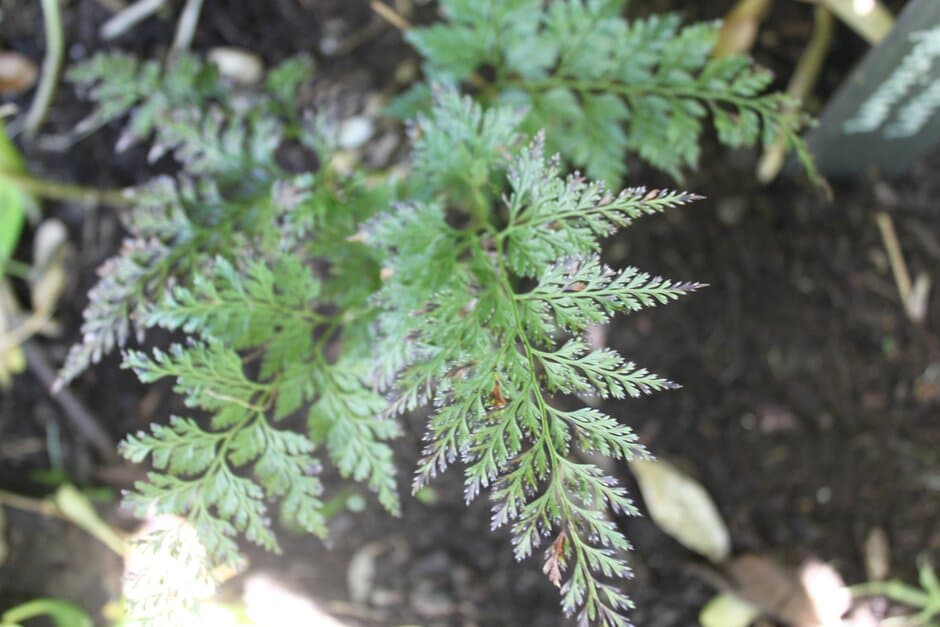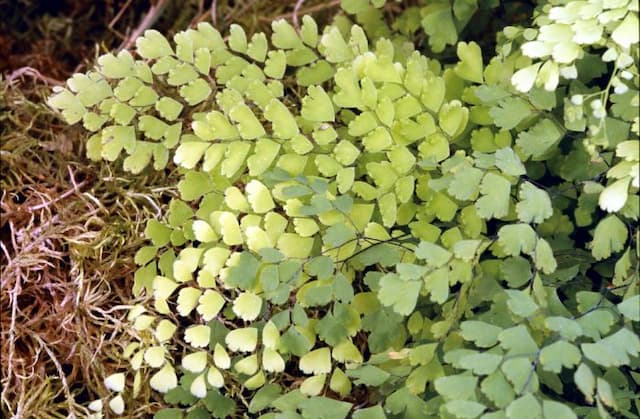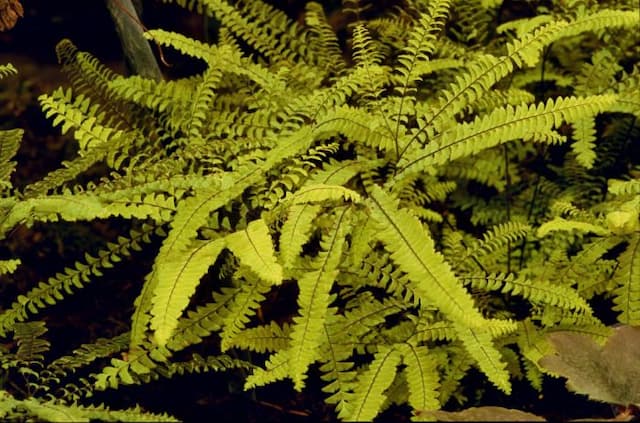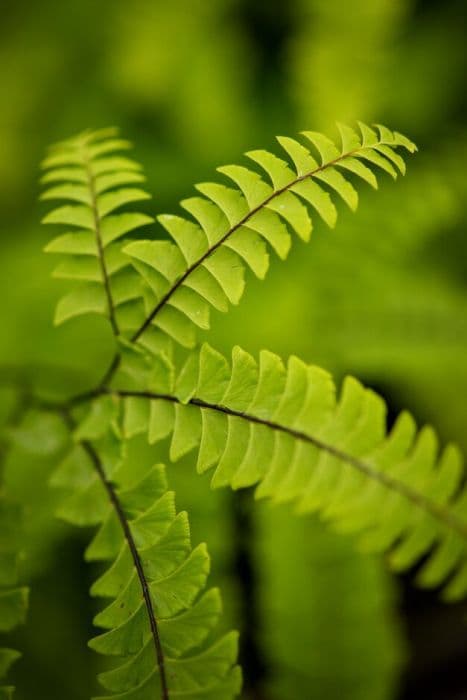Japanese Clawed Fern Onychium japonicum

ABOUT
Onychium japonicum, commonly known as Japanese Claw Fern, is a delicate-looking fern distinguished by its finely divided fronds that resemble the intricate appearance of a carrot top. The texture of the fronds is somewhat feathery and airy, giving the plant a light and graceful presence. The leaves are green and have a soft, somewhat velvety feel. They are compound, which means they are divided into multiple small leaflets that spread out from the central stem, forming a triangular shape as they mature. The stem, or stipe, that supports the fronds tends to be slender and can have a pale color with a slightly contrasting tone compared to the vivid green of the leaves. This fern species manifests a certain symmetry and pattern in its growth, creating a visual rhythm that can be quite calming and attractive to look at. Overall, the Japanese Claw Fern is appreciated for its intricate foliage and the elegance it adds to shady garden areas or as a cultivated houseplant.
About this plant
 Names
NamesFamily
Onychiuridae
Synonyms
Japanese Clawed Fern, Carrot Fern
Common names
Pteris japonica, Aleuritopteris farinosa, Onychium siliculosum, Pteris farinosa, Pteris siliculosa.
 Toxicity
ToxicityTo humans
Onychium japonicum, commonly known as Japanese Claw Fern, is not widely known for being toxic to humans. There is limited information available regarding its potential toxicity, but it is generally not considered poisonous. Therefore, it is not commonly associated with any symptoms of poisoning when touched or ingested. However, as with any plant, it's always possible for individuals to have allergies or adverse reactions, so it is advisable to exercise caution if you are not familiar with this particular fern.
To pets
Onychium japonicum, or Japanese Claw Fern, does not have a reputation for being toxic to pets. There is a lack of evidence pointing towards any significant poisonous attributes of this plant in relation to animals. As such, it is not known to cause any specific symptoms of poisoning in pets if ingested. Nonetheless, individual animals can sometimes have unique sensitivities, and as a precaution, it is generally wise to prevent pets from consuming plants that are not explicitly known to be safe.
 Characteristics
CharacteristicsLife cycle
Perennials
Foliage type
Deciduous
Color of leaves
Green
Height
1-2 feet (30-60 cm)
Spread
1-2 feet (30-60 cm)
Plant type
Herb
Hardiness zones
8
Native area
Asia
Benefits
 General Benefits
General Benefits- Culinary uses: Onychium japonicum, commonly known as "Japanese fern," is edible and used as a vegetable in some Asian cuisines, providing a unique flavor and texture to dishes.
- Ornamental value: With its feathery, delicate fronds, the Japanese fern can be a beautiful addition to gardens, terrariums, and indoor plant collections.
- Habitat restoration: This fern can be used in natural landscaping and habitat restoration projects, as it is a native species in certain regions and can help maintain local biodiversity.
- Erosion control: The root systems of Japanese fern can help stabilize soil and prevent erosion in hilly or sloped areas of the garden.
- Low maintenance: As a hardy and adaptable plant, the Japanese fern often requires minimal care, making it a suitable choice for beginner gardeners or those with less time for upkeep.
- Shade tolerance: Onychium japonicum thrives in shaded areas where other plants might struggle, making it a valuable ground cover for dimly lit gardens.
- Companion planting: The fern can serve as an excellent companion plant, providing ground cover and moisture retention for neighboring plants.
 Medical Properties
Medical Properties- Anti-inflammatory: Onychium japonicum contains compounds believed to reduce inflammation.
- Antioxidant: The plant may contain bioactive substances with antioxidant properties.
- Hepatoprotective: Some studies suggest a liver-protective effect of Onychium japonicum.
- Immunomodulatory effects: There are indications that the plant may have effects on the immune system.
 Air-purifying Qualities
Air-purifying QualitiesThis plant is not specifically known for air purifying qualities.
 Other Uses
Other Uses- As a natural dye: The leaves of the Japanese Brake fern may be used to create a range of green and yellow dyes for textiles.
- In landscaping: Due to its delicate appearance, it can be used as a groundcover or an accent piece in shade gardens or terrariums.
- In floral arrangements: The fronds of Japanese Brake fern are sometimes used in floral arrangements for their intricate patterns and interesting texture.
- As a bioindicator: The presence of Onychium japonicum in the wild can indicate a well-preserved environment, as it prefers clean, unpolluted areas.
- As an educational tool: It is often included in botany programs for studying fern life cycles and spore propagation.
- For culinary presentation: Its leaves can be used as a natural and decorative backdrop for plating dishes in high-end cuisine.
- In art: Artists may use the silhouette or shape of the Japanese Brake fronds as a motif in designs or as a stencil for printing and textile work.
- As a humidity indicator: The fern's requirement for high humidity could serve as a low-tech humidity monitor in greenhouses or conservatories.
- In photography: The fern's structure provides an intriguing subject for macro photography and nature photography enthusiasts.
- As a natural craft material: Dried fronds can be used in crafting, for creating bookmarks, or as part of mixed-media art projects.
Interesting Facts
 Feng Shui
Feng ShuiThe Japanese Claw Fern is not used in Feng Shui practice.
 Zodiac Sign Compitability
Zodiac Sign CompitabilityThe Japanese Claw Fern is not used in astrology practice.
 Plant Symbolism
Plant Symbolism- Resilience: Onychium japonicum, commonly known as the Japanese fern, often grows in challenging conditions and is adaptable to different environments, symbolizing the ability to endure adversity.
- Elegance: With its delicate and intricate fronds, the Japanese fern is associated with grace and a refined aesthetic, much like the prizing of minimalism and elegance in Japanese culture.
- Secretiveness: Ferns in general, including the Japanese fern, have been symbols of secrecy and discretion due to their hidden reproductive parts (spores as opposed to obvious flowers).
- New Beginnings: Ferns are among the oldest plants, thus they are often associated with ancient wisdom and new growth, making them emblematic of fresh starts and rejuvenation.
- Shelter: The dense growth of Japanese ferns can provide shelter to smaller creatures in the wild, representing protection and safety.
 Water
WaterThe Japanese claw fern should be watered once the top inch of soil feels dry to the touch, typically once every week, but the frequency can vary depending on environmental conditions like temperature and humidity. Use room-temperature water and gently pour it around the base of the plant until the water starts to drain from the bottom of the pot, ensuring the soil is moist but not waterlogged. An average amount to provide is around 16 to 20 ounces per watering for a medium-sized pot. During the winter, water less frequently as the plant's growth slows down and it requires less moisture.
 Light
LightThe Japanese claw fern flourishes in bright, indirect light. It should be placed in a spot where it can receive plenty of light but is shielded from direct sunlight, which can scorch its delicate fronds. A north or east-facing window typically provides the ideal lighting conditions for this plant to thrive.
 Temperature
TemperatureThe Japanese claw fern prefers a consistent temperature range between 60°F and 75°F. It can tolerate a minimum of about 50°F, but temperatures below this can cause harm to the plant. Avoid placing the fern near drafts or heat sources that can cause sudden fluctuations in temperature.
 Pruning
PruningPruning the Japanese claw fern is mainly done to maintain its appearance and remove any brown or damaged fronds. Pruning can be done as needed throughout the year, but it is best to do any major pruning in the spring or early summer when the plant is actively growing. Use clean scissors or pruning shears to make clean cuts close to the base of the unwanted fronds.
 Cleaning
CleaningAs needed
 Soil
SoilCarrot fern thrives in a well-draining, rich organic soil mix with a pH of 6.0 to 7.5. A combination of loamy garden soil, peat moss, and perlite or sand can provide optimal growth conditions for this fern species.
 Repotting
RepottingCarrot ferns should generally be repotted every 2 to 3 years to refresh the soil and accommodate growth. It's important to handle their delicate fronds with care during the repotting process.
 Humidity & Misting
Humidity & MistingCarrot ferns prefer high humidity levels, ideally between 60% and 80%. They thrive in moist environments but can adapt to slightly lower humidity levels if necessary.
 Suitable locations
Suitable locationsIndoor
Ensure high humidity and indirect light indoors.
Outdoor
Plant in shaded area with rich, moist soil.
Hardiness zone
9-11 USDA
 Life cycle
Life cycleOnychium japonicum, commonly known as Japanese Claw Fern, begins its life cycle as a spore, which germinates to form a small, heart-shaped gametophyte (prothallus) upon finding suitable moist conditions. The gametophyte houses both male and female reproductive organs that, upon maturation, facilitate fertilization, leading to the development of a new sporophyte – the recognizable fern plant. This young sporophyte gradually develops roots, fronds, and a rhizome as it matures. The fronds unroll from a coiled position, a process known as circinate vernation, and the fern establishes itself, gaining nutrients through photosynthesis. As the plant reaches maturity, it produces sori on the underside of its fronds; these sori contain sporangia, where spores are produced through meiosis. Spores are then released to the environment to begin the life cycle anew when conditions are once again favorable.
 Propogation
PropogationPropogation time
Spring to early summer
The most popular method for propagating Onychium japonicum, commonly known as Japanese Carrot Fern, is through spores which are typically collected during the plant's sporulation period. To propagate by spores, one must first harvest the spores from a mature plant when they are ripe. This usually involves waiting until the undersides of the fronds develop a brownish color, indicating spore maturity. The spores should then be sown on the surface of a fine, sterilized potting mix, and kept in a warm and humid environment to encourage germination. It is crucial to maintain a steady moisture level without saturating the soil to prevent the spores from being washed away or developing mold. Germination of spores can be a slow process, often taking a few weeks to several months, after which the young ferns can be carefully transplanted into individual pots to continue growing.




